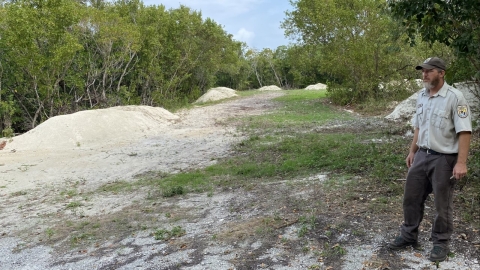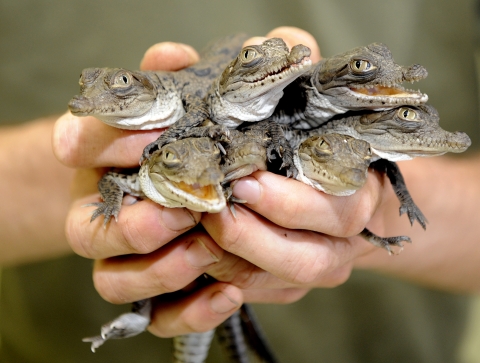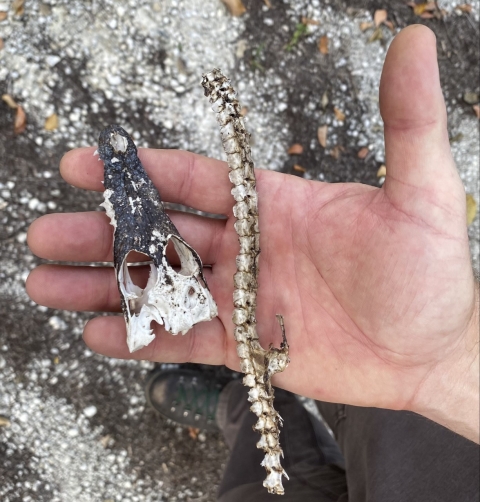Key Largo, Florida -- If Florida is the poster child for climate change climate change
Climate change includes both global warming driven by human-induced emissions of greenhouse gases and the resulting large-scale shifts in weather patterns. Though there have been previous periods of climatic change, since the mid-20th century humans have had an unprecedented impact on Earth's climate system and caused change on a global scale.
Learn more about climate change run amok then the Keys – the fragile, low-lying string of tropical islands that curves out into the Atlantic Ocean and the Gulf of Mexico – are the even more troubled siblings struggling against rising seas and saltwater intrusion.
Nowhere along the 150-mile-long archipelago does the elevation rise above 18 feet. Average height: 3.2 feet above sea level. It doesn’t take a rocket scientist to discern what harm a projected three-to-eight-foot rise in the Atlantic Ocean by 2100 will do to the Keys.
Or the crocodiles.
Even the armored and menacing-looking American crocodile, who lives only in south Florida, can’t escape the ravages of a warming world. The federally threatened species, kin to the darker-skinned and more plentiful American alligator, suffers from rising temperatures and rising seas.
Yet, paradoxically, there are more crocodiles in Florida today than at any time in the last half century. Protections offered by the Endangered Species Act surely help boost their numbers. A robust artificial-nest building program also ensures the survival of more baby crocs. And, like many animals and plants, migration northward toward fresher water and more stable habitats has become a life-saving necessity.
Still, the climate threat is only expected to worsen with a particular harsh prognosis for the mangrove habitats crocodiles call home. And, with south Florida building out virtually every square foot of coastal property, crocodiles may struggle to find room to nest.
“The seas are rising much faster than they have the last three millennium and that’s having a profound effect on natural communities, vegetation and wildlife,” says Chris Bergh, the South Florida program manager for The Nature Conservancy who grew up in the Keys. “If we fail to address the root causes of climate change, or fail to slow down the pace, the islands as we know them today will be under water.”
Refuge rock star
American crocodiles get a bad rap. Shy and secretive by nature, crocs go out of their way to avoid conflict with humans belying Tarzanesque depictions of large, toothy reptiles chomping on unsuspecting explorers. They inhabit the coastal mangrove forests of Cuba, Jamaica, Mexico and Ecuador. South Florida is their northernmost reach. They can live past 50. Males can grow beyond eight feet. Crocs are distinguished from their more ubiquitous cousin, the alligator, by their olive-green skin, slender snouts, and the visibility of the fourth tooth on their lower jaw when their mouths are shut. They were listed as endangered by the U.S. Fish and Wildlife Service in 1975.
Back then, a few hundred crocs inhabited the brackish ponds, coves and creeks of Florida’s mangrove swamps. The coastal crocodilians were hunted to near extinction to satisfy the demand for purses, wallets, shoes, and belts. Florida’s unrelenting sprawl wiped out most of the reptiles’ habitat. Starting in the 1960s, developers began buying up waterfront properties in North Key Largo with hopes of building massive resorts and bedroom communities. They gouged out canals and stacked the spoils into neat rows to serve as marinas. Recessions, bankruptcies, illegal permits, and a heightened awareness of the need to conserve land for a variety of threatened and endangered species doomed some of the developments.
Out of the developers’ broken dreams, in 1980, rose the Crocodile Lake National Wildlife Refuge. Much of the refuge that hugs U.S. 1 atop the Keys housed antiaircraft missiles intended to shoot down Soviet bombers approaching Florida from Cuba. In addition to the mangroves and salt marshes, the refuge is renowned for its hardwood hammocks which provide much-needed habitat for a slew of threatened and endangered species, including the Key Largo wood rat, the Schaus’ swallowtail butterfly, and the Florida semaphore cactus. Today, the 6,700–acre refuge is off-limits to the public, though a butterfly garden is open daily and more intrepid visitors can volunteer to track invasive pythons.
The crocodile, though, is the refuge’s rock star. And its habitat is under siege. The state of Florida’s Climate Adaptation Explorer reports that the crocodile’s habitat “is expected to become significantly inundated” with at least a third of its home turf disappearing by 2100.
“I’ve been here nine years and I can definitely tell you that the water’s coming up quick,” says Jeremy Dixon, the refuge manager standing amidst a field of artificial crocodile nests. “On the water’s edge, where the saltwater is moving in, we’re transitioning from upland species to wetland species. At some point buttonwoods can’t withstand saltwater inundation so it’s transformed into mangroves. Change is happening so fast. We’re seeing huge impacts.”
The Atlantic Ocean off Florida has risen almost a foot over the last century and will likely rise at least another foot by 2050. Key Largo sits, on average, seven feet above sea level and could lose hundreds, if not thousands of acres of coastal habitat.
“Florida is among the most vulnerable states to climate change impacts, primarily due to a combination of increasing ocean temperatures, sea level rise, extreme weather events, low elevation, and heavy coastal human development,” reads the National Fish, Wildlife, and Plants Climate Adaptation Strategy published last year by the National Oceanic and Atmospheric Administration.
A warming world melts glaciers and causes seas to rise. Hotter temperatures also warm the oceans. And, since water expands as it heats up, the seas rise even higher.
A 2020 study in the Journal of Thermal Biology tracked the relationship between sea surface temperatures and the time when crocodiles hatch in south Florida. Scientists with the Service, the United States Geological Survey, and other partners found that, over the last four decades, temperatures have increased, on average, 0.05 degrees centigrade per year. Consequently, at one test site in the nearby Everglades National Park, crocodile babies hatch 1.5 days earlier every two years. The scientists didn’t explore potential ramifications of the earlier hatchings. Other studies, though, show that higher temperatures produce more male than female crocodiles.
Anthropogenic irony
Yet the very factors that harm the American crocodile’s survival – man and his modern ways – afford previously unheard-of opportunities for the reptile’s survival. Fifty years ago, the remaining crocs nested in Key Largo and the northeastern corner of Florida Bay in the Everglades National Park. Running out of space, and freshwater, the crocs adapted by moving north and west. Today, they’re found as far north as Key Biscayne, below Miami, and Marco Island on the Gulf. They inhabit public beaches, marinas, golf courses, even an airport.
The “Croc Docs” are on their tails. The University of Florida scientists have tracked the reptiles’ whereabouts – and notched their successes – for 50 years. They tallied 93 nests in the 1970s – and a total of 3,013 nests by 2020. More importantly, the nesting success rate rose from 61 percent to almost 90 percent.
And here’s where it gets interesting. While the Endangered Species Act and the creation of croc-friendly habitats like Crocodile Lake refuge deserve much credit for the animal’s survival, so too do man-made canals and man-made maternity wards. Consider the Turkey Point nuclear power plant in Homestead. The company that owns the nuke plant, Florida Power and Light, maintains the artificial, flood-proof berms that crocodiles prefer for nesting. And the 40 cooling ponds afford the fresh water the hatchlings need. Only two nests were counted at Turkey Point in the 1970s; 540 have been tallied since, according to the University of Florida.
Or consider the Cape Sable area of Everglades National Park. Freshwater marshes and lakes once covered the southwestern corner of Florida until settlers in the early 1900s drained the land for farms. Two of the major canals, though, were plugged in the 1980s and the crocodiles began nesting on the levees. There were no nests in Cape Sable during the 1970s and, in the 2020s, there were 1,180.
And then there’s Crocodile Lake refuge. Dixon, the refuge manager, tours a stripped-bare field alongside a red mangrove forest. Canals, intended for a marina that was never built, stretch a half-mile into Barnes Sound. Twenty man-made mounds of packed sand, five feet long and two feet high, sit close enough to the water, yet far enough upland to avoid most of the damage wrought by rising seas.
“The really cool thing is we have nesting sites right next to great hatchling habitat,” Dixon says. “Crocodiles will use what’s available. You put sand out there and they’ll be happy.”
The reptiles nest between March and May. Dixon and crew counted eight active nests this year and tagged 48 hatchlings. Over the last 15 years, the Service, along with state, federal and nonprofit partners, built 40 maternity wards for expectant croc moms on the refuge. Crocodile Lake has totaled 258 nests over the years.
In 2007, the American crocodile in Florida was down-listed from endangered to threatened. An estimated 2,700 crocs live in the Keys and the Everglades.
“What we’re doing is working,” Dixon says.
Numbers leveling
But for how long? In this century’s first decade, 59 nests were counted at Crocodile Lake, according to the UF study published in the June 2022 edition of Frontiers in Ecology and Evolution. In the last decade, the number of nests dropped to 55. The drop-off is similar at Turkey Point: 202 to 192 nests. (Nest numbers continued to rise at Cape Sable.)
In all, five of the 12 sites studied by UF showed lower nesting levels the last two decades.
“We have no explanation, or even a good speculation, for why the increase in nesting leveled off during 2010 to 2020,” the UF scientists write before offering a few possible explanations.
Nests fail primarily due to flooding or drought, extreme weather events that are hallmarks of climate change. 2015, for example, was a very bad year for nests with higher-than-usual temperatures causing water temperatures – and salinity levels – to rise. As the seas rise, more low-lying nests flood.
Rising seas, temperatures, and salinity levels appear to push the crocodiles further and further north. Steven Bertone, an environmental specialist with the Florida Department of Environmental Protection, says crocs from Cape Sable appear to be moving up Florida’s west coast nearing Goodland and Marco Island. There they find mangrove forests and freshwater marshes a good distance from the saltier estuaries found along the coast.
If they keep migrating, though, they’ll hit the subdivisions and highways – stuff made by man – that is endemic to south Florida, yet bad for crocodiles. It remains to be seen whether other anthropogenic stuff, like canals and levees, offer enough of a benefit to keep the reptiles from going extinct as the climate warms.
“The adaptive capacity that American crocodiles exhibited in Florida gave the species advantages to face changes in climate and landscape over the last 50 years,” the UF scientists write. “However, it does not imply that the adaptive capacity of the species to face these changes ... cannot reach a limit if changes continue.”






